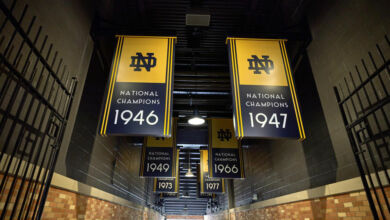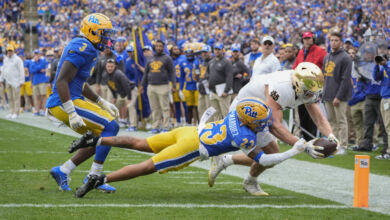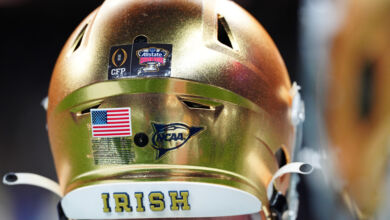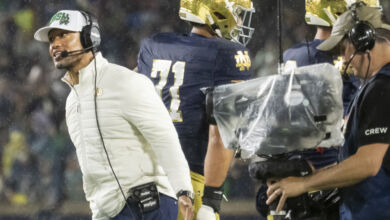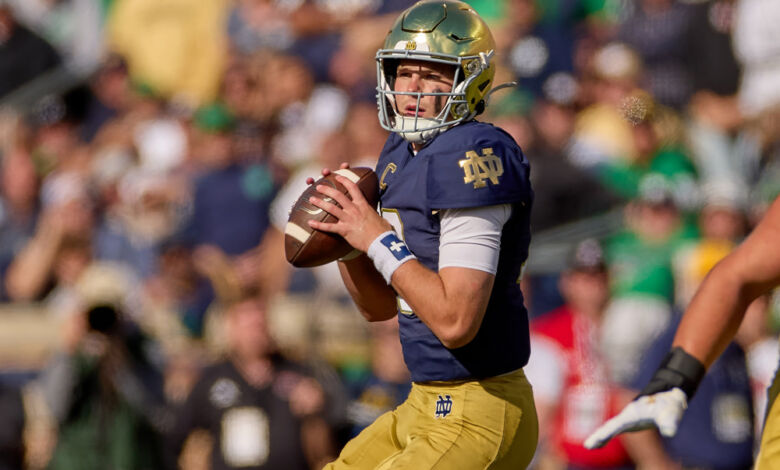
With the first of two bye weeks having arrived, Notre Dame now has some valuable time to work on improving certain aspects of its overall game. The 4-1 record compiled so far looks impressive but still needs work if the Irish hope to gain a postseason berth.
Listed below are three particular areas that could use some work:
Upgrading the Passing Game
After last year’s regular season ended, the Notre Dame receiving corps took a major hit with an array of departures through the transfer portal. While the Irish filled some of those holes with some transfers of their own and looked to speed the development of the raw talent remaining, any success in those departments has thus far been limited.
Regarding the wideouts, the tandem of Beaux Collins and Jaden Greathouse have combined to catch exactly one-third of the Irish pass attempts. Yet, they’re only contributing an average of 64 yards of offense per game for the first five contests. As a whole, those wide receivers have caught the only two scoring tosses among this select unit.
Traditionally, Notre Dame tight ends have been an integral part of the team’s offense. However, during the first five games this season, that position has been relatively quiet. The four players who have caught at least one pass have combined for just 18 receptions, gaining 179 yards and scoring two touchdowns.
Reasons for these relatively scant numbers begin quarterback Riley Leonard’s struggles in opening up the passing game. Another factor includes the slow but steady increase in using Mitchell Evans, who is returning from last year’s season-ending ACL injury. Finally, Cooper Flanagan’s recent ankle injury adds one more component to this situation.
Notre Dame has won four of its five games so far, with the running game driving that success on offense. Right now, Leonard is averaging only 150 passing yards per game, which doesn’t equate with the potential of his passing options. Working to upgrade that number should be a priority during this brief respite.
Making Strides with the Offensive Line
After its first five games, Notre Dame’s offensive line finds itself 58th among all FBS teams in the area of sacks allowed per game. That’s not terrible positioning but it needs to improve over the final regular season games. Such early issues were inevitable, given the massive changeover that was required by both offseason departures and this season’s injury toll.
Even before the season started, the Irish lost tackle Charles Jagusah for the season. Center Ashton Craig’s season then ended against Purdue, with right guard Billy Scharuth still on the mend after an ankle injury against the Boilermakers. In the latter case, no timetable concerning Scharuth’s return has been offered.
Despite such setbacks, the line has continued to open enough holes for the running game, which is averaging 214 yards per game. Leonard’s mobility has no doubt helped to avoid some potential sacks, but giving him some additional time to find a potential target could pay dividends.
The line has allowed eight sacks so far, compared to four at this point last season, while opposing quarterback hurries have dipped from 11 to nine. That difference should widen considerably during the next two games since the Irish line allowed 11 combined hurries in the Duke and Louisville contests last year. In contrast, this year’s squad will be facing Stanford and Georgia Tech.
The usual problem of penalties such as holding and false starts is a continuing work in progress. How much can be done to fix that is open to question since the problem was in evidence last year as well. Any improvement would be welcomed.
Third Down and Out
Eating up time on the clock and driving opposing defenses to fatigue is possible when teams can regularly convert on third down. That goal has been elusive for the 2024 Notre Dame offense, which has only converted 19 of 54 opportunities, a success rate of 36 percent. Last year at this point, the Irish had moved the chains 29 of 54 times after a third-down play.
Not surprisingly, the two most successful games for the Irish on third down were in the Purdue and Miami of Ohio wins, in which the Irish outscored their foes 94-10. In those victories, 12 of 23 total conversions resulted in a success rate of 52 percent. The numbers for their other three clashes are notably less inviting. seven of 31 conversions, a success rate of just under 23 percent.
Marcus Freeman has spoken about his aggressive approach, including going for it on fourth down. That strategy has worked four of the seven times it’s been tried this season but one of those failures made the Louisville ending one that increased the blood pressure of Irish fans. Avoiding that issue going forward by converting the down before is something in need of greater attention before the Irish face Stanford.
